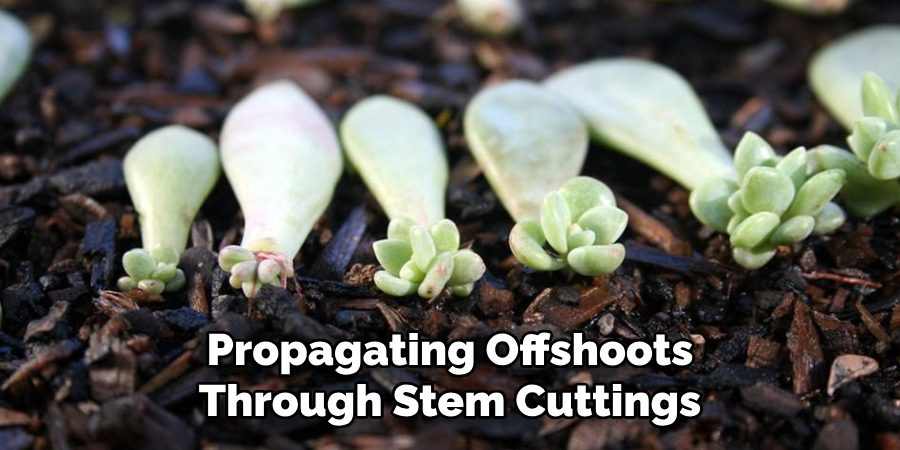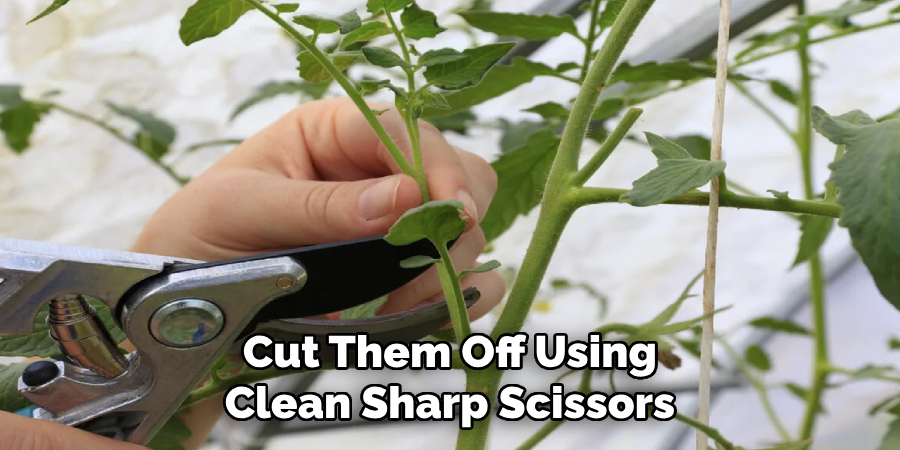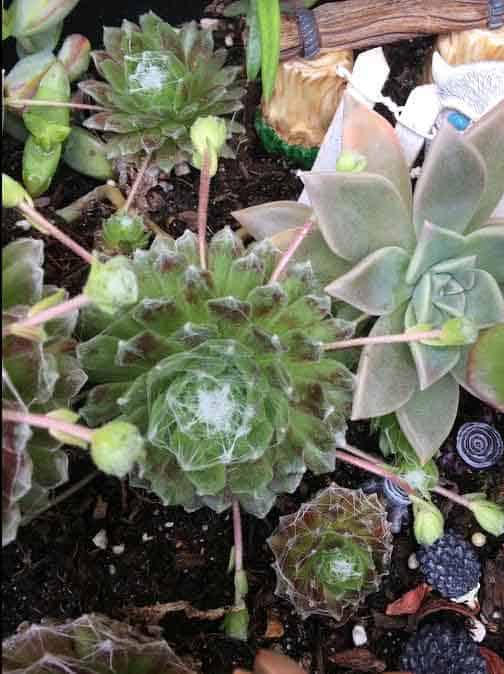To remove succulent offshoots, gently separate them from the parent plant using a clean, sharp knife. Succulent offshoots can be easily removed from the parent plant by following a simple process.
With the help of a clean and sharp knife, carefully separate the offshoots from the main plant, ensuring that each offshoot has its own roots. This can be done by making a clean, straight cut near the base of the offshoot, taking care not to damage the main plant.
Once the offshoots are removed, allow them to dry for a few days to form calluses before planting them in a well-draining soil mix. By following these steps, you can successfully propagate your succulents and create new plants to enjoy.

Credit: harddy.com
Understanding Succulent Offshoots
Succulent offshoots are small plants that grow alongside the main succulent. These offshoots are also known as “pups” and serve as a means of reproduction for the parent plant. Succulents produce offshoots as a way to propagate and expand their population.
They are formed when the parent plant sends out lateral shoots or new growth from the base or sides. There are different types of offshoots, including basal offshoots, which emerge from the base of the plant, and lateral offshoots, which grow from the sides.
By understanding the different types of offshoots, succulent enthusiasts can easily identify and remove them if desired. Removing offshoots can help control the size of the succulent and allow for separate plantings. It’s important to handle offshoots carefully during removal to avoid damaging the parent plant.
Overall, understanding succulent offshoots provides valuable knowledge for succulent care and propagation.
Tools And Materials Needed
To remove succulent offshoots, you will need essential tools and materials. These include a sharp knife or pruning shears, clean and sterilized pots or containers, and well-draining potting soil. When selecting a pot or container, choose one that is the appropriate size for the offshoot and has drainage holes.
Prepare the potting soil by mixing equal parts of succulent soil mix and perlite or coarse sand. Gently remove the offshoot from the mother plant using the sharp knife or pruning shears, ensuring a clean and smooth cut. Allow the offshoot to callus for a few days before placing it in the prepared potting soil.
Plant the offshoot in the soil, making sure it is stable and firmly rooted. Place the pot in a bright area with indirect sunlight and water sparingly, allowing the soil to dry out between waterings. With proper care, the offshoot will grow into a new succulent plant.
Step-By-Step Guide To Removing Succulent Offshoots
Assess the offshoots’ health to ensure they are ready for removal. Prepare the parent succulent plant by watering it lightly a day or two before the process. One technique for removing offshoots without harming the parent plant involves gently twisting the offshoot until it detaches.
Use a clean, sharp knife to cut the offshoot from the parent plant if twisting does not work. Stubborn or deeply rooted offshoots may require a different approach. You can wait for the offshoot to grow larger and develop its own roots, making it easier to separate.
Alternatively, you can carefully dig around the offshoot and cut any connecting roots to safely remove it. By following these steps, you can successfully remove succulent offshoots while preserving the health of the parent plant.
Caring For Separated Succulent Offshoots
When it comes to caring for separated succulent offshoots, it is important to follow best practices for replanting. Proper watering and light requirements should be observed to ensure their healthy growth. To avoid transplant shock, make sure to acclimate the offshoots gradually to their new environment.
Start by placing them in a shaded area and gradually increase their exposure to sunlight. Additionally, it is important to avoid overwatering the offshoots as this can lead to root rot. Allow the soil to dry out between waterings and ensure proper drainage.
Moreover, be cautious not to use a pot that is too large for the offshoots as this can delay their growth. By following these tips, you can successfully remove succulent offshoots and help them thrive in their new location.
Propagation Options For Offshoots
Propagation options for offshoots include rooting them in water and using rooting hormone for faster growth. Another method is propagating offshoots through stem cuttings. Rooting offshoots in water is a simple process that involves placing the offshoots in a container filled with water and allowing them to develop roots.
Using rooting hormone can help accelerate the growth of the offshoots by providing them with essential nutrients and hormones. Propagating offshoots through stem cuttings entails cutting a section of the offshoot with a sharp, clean knife and placing it in a suitable potting mix.

With proper care and attention, these offshoots will develop into new healthy succulent plants, expanding your collection. Experiment with different propagation techniques to find the one that works best for you and enjoy the satisfaction of growing your succulent family.
Common Mistakes To Avoid
Proper care is essential when removing succulent offshoots to avoid common mistakes. One such mistake is overwatering the separated offshoots. Overwatering can lead to root rot and damage the newly separated plants. Another mistake to avoid is improper handling during the separation process.
It’s crucial to handle the offshoots gently and with care to prevent any harm. Additionally, neglecting to monitor for pests or diseases can be a grave mistake. Regularly inspect the offshoots for any signs of pests or diseases and take appropriate action if necessary.
By following these guidelines, you can ensure successful removal of succulent offshoots without making common mistakes. Remember to provide proper care and attention to the newly separated plants for their healthy growth.
Troubleshooting And Faqs
Wilting or yellowing offshoots can be a concern for succulent enthusiasts. To address this issue, first, ensure you are not over or underwatering your plants. Finding the right balance is key. Secondly, check for root rot, as this could be causing the discoloration.
If this is the case, remove the affected offshoots and repot in fresh soil. As for establishing roots, it typically takes around two to three weeks for offshoots to develop a solid root system. During this period, provide them with indirect sunlight and mist the soil occasionally.
When it comes to transplantation, it is best to wait until the offshoots have established strong roots before transplanting directly into the ground. This will promote better growth and survival rates for your succulent offshoots.
Frequently Asked Questions On How To Remove Succulent Offshoots
How To Remove Offshoots From Succulents?
To remove offshoots from succulents, gently twist or cut them off using clean, sharp scissors or gardening shears. Ensure that you leave a clean cut on both the mother plant and offshoot. Allow the offshoot to callus for a day or two before planting it in a well-draining soil mix.

When Is The Best Time To Remove Succulent Offshoots?
The best time to remove succulent offshoots is during the growing season, which is typically in spring or summer. This is when the plants are actively growing and have better chances of root establishment. Avoid removing offshoots during dormant periods, as the success rate may be lower.
Can You Propagate Succulent Offshoots In Water?
While succulent offshoots can be propagated in water, it is not the recommended method. Succulents prefer well-draining soil, so water propagation can lead to root rot or other issues. It is best to directly plant the offshoots in a suitable succulent soil mix to ensure their successful growth and development.
How Long Does It Take For Succulent Offshoots To Root?
Succulent offshoots typically take around 2 to 4 weeks to root properly. The exact time can vary depending on various factors such as the succulent species, environmental conditions, and the health of the offshoot. Patience is key during this process, and it is important to provide the offshoot with proper care during the rooting period.
What Should I Do If The Offshoot Doesn’T Root?
If the offshoot doesn’t root, don’t fret! It is common for some offshoots to fail in rooting. Simply remove the unsuccessful offshoot and try again with a fresh one. Adjusting environmental conditions such as light, temperature, and humidity can also improve the success rate.
Experimentation and persistence are key in propagating succulent offshoots.
How Soon Can I Separate Offshoots From The Mother Plant?
You can separate offshoots from the mother plant once they have grown to a suitable size. Typically, the offshoots should have developed roots and several sets of true leaves before separating them. This ensures that they have enough energy and resources to grow independently and have better chances of survival.
Conclusion
To successfully remove succulent offshoots, it’s essential to follow proper techniques and provide the necessary care. By ensuring a clean cut, allowing the wound to dry, and using proper soil and watering techniques, you can promote successful offshoot removal and propagation.
Remember to handle the offshoots with care, using clean tools to avoid introducing any bacteria or disease. Regularly monitor the progress of the offshoots and adjust their care accordingly. With time and patience, you’ll witness new growth and flourishing succulents.
Share your newfound knowledge with fellow succulent enthusiasts to foster a thriving community. So, go ahead and start removing those succulent offshoots with confidence, knowing you have the necessary skills and understanding to support their growth.

